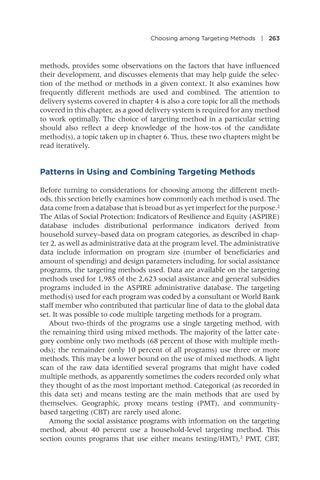Choosing among Targeting Methods | 263
methods, provides some observations on the factors that have influenced their development, and discusses elements that may help guide the selection of the method or methods in a given context. It also examines how frequently different methods are used and combined. The attention to delivery systems covered in chapter 4 is also a core topic for all the methods covered in this chapter, as a good delivery system is required for any method to work optimally. The choice of targeting method in a particular setting should also reflect a deep knowledge of the how-tos of the candidate method(s), a topic taken up in chapter 6. Thus, these two chapters might be read iteratively.
Patterns in Using and Combining Targeting Methods Before turning to considerations for choosing among the different methods, this section briefly examines how commonly each method is used. The data come from a database that is broad but as yet imperfect for the p urpose.2 The Atlas of Social Protection: Indicators of Resilience and Equity (ASPIRE) database includes distributional performance indicators derived from household survey–based data on program categories, as described in chapter 2, as well as administrative data at the program level. The administrative data include information on program size (number of beneficiaries and amount of spending) and design parameters including, for social assistance programs, the targeting methods used. Data are available on the targeting methods used for 1,985 of the 2,623 social assistance and general subsidies programs included in the ASPIRE administrative database. The targeting method(s) used for each program was coded by a consultant or World Bank staff member who contributed that particular line of data to the global data set. It was possible to code multiple targeting methods for a program. About two-thirds of the programs use a single targeting method, with the remaining third using mixed methods. The majority of the latter category combine only two methods (68 percent of those with multiple methods); the remainder (only 10 percent of all programs) use three or more methods. This may be a lower bound on the use of mixed methods. A light scan of the raw data identified several programs that might have coded multiple methods, as apparently sometimes the coders recorded only what they thought of as the most important method. Categorical (as recorded in this data set) and means testing are the main methods that are used by themselves. Geographic, proxy means testing (PMT), and communitybased targeting (CBT) are rarely used alone. Among the social assistance programs with information on the targeting method, about 40 percent use a household-level targeting method. This section counts programs that use either means testing/HMT),3 PMT, CBT,


